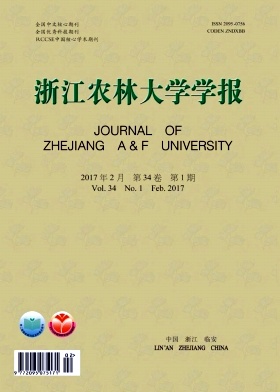-
米老排Mytilaria laosensis别名壳菜果、米显灵、三角枫、马蹄荷、山油桐,为金缕梅科Hamamelidaceae壳菜果属Mytilaria常绿大乔木,是南亚热带地区的珍贵阔叶乡土树种[1],天然分布于中国云南南部、广西西南部和广东西部。越南北部和老挝也有分布[2]。米老排生长快、成材早、干性通直、材质优良、适应性较广、抗性强,是优良的制浆造纸、家具和建筑原料[3];同时,米老排能改良土壤理化性质,并可作为防火树种[4],具有重要的生态利用价值,已成为华南重要的生态经济型树种。目前,对米老排的研究主要集中在天然群体遗传多样性[5]、幼苗培育[6]、人工林生长规律[7]和混交林对土壤的影响[8]等方面,而在米老排表型变异方面的研究,仅见袁洁等[9]研究了天然群体的种实表型变异,对种源试验林表型变异的研究鲜见报道。近年来,有学者对麻疯树Jatropha curcas[10],木荷Schima superba[11],毛红椿Toona ciliate[12],苦楝Melia azedarach[13],山核桃Carya dabieshanensis[14],枫香Liguidambar formosana[15],梭梭Haloxylon ammodendron[16],南酸枣Choerospondias axillaris[17],黄山松Pinus taiwanensis[18],红楠Machilus thunbergii[19],花楸树Sorbus pohuashanensis[20],拟单性木兰Parakmeria latungensis[21],麻栎Quercus acutissima[22]等树种设置不同种源试验并对其表型性状进行了研究,认为表型变异的分析方法可以系统地揭示种源间的遗传变异规律和检测植物对不同环境的适应水平,进而为当地生境筛选出优良繁育材料[23-24]。因此,研究不同种源的表型变异, 有助于全面准确地了解不同种源遗传变异规律和种源内个体的形态变异,为优良种源的选育和种质创新提供理论依据[25]。本研究利用已建米老排种源试验林,对不同地理种源米老排的干形特征、叶部性状和树皮性状等表型特征进行了分析,以期揭示米老排表型性状在种源间、种源内的变异特点和地理变异规律及其与生态因子的相关性,为选择米老排优良种源提供科学依据。
HTML
-
研究地点位于广东省西江林业局西江林场,地处23°27′N,111°30′E。林区立地条件优越,属亚热带气候。年平均气温为21.6 ℃,最高气温36.2 ℃,年平均降水量1 600 mm,年平均湿度82%;海拔为100~680 m。土壤多为赤红壤。
供试的8个种源来自其自然分布区的广西和广东,共采集了101个家系。各种源产地及地理概况见表 1。于2010年营造米老排种源/家系试验林,试验林采用随机区组设计,单株小区,设30个区组,株行距为3 m × 3 m,区组外围均设保护行1行·区组-1。
种源编号 产地 北纬 东经 海拔/m 年均气温/℃ 年降水量/mm 采集数/株 GDFK 广东封开 23°27’ 111°54’ 436 20.7 1 740.0 3 GXDB 广西德保 23°03’ 106°40’ 743 19.5 1 462.0 20 GXFC 广西防城 21°52’ 107°33’ 483 22.0 2 822.9 3 GXJX 广西靖西 23°03’ 106°36’ 761 19.3 1 631.9 24 GXLZ 广西龙州 22°16’ 106°43’ 526 22.1 1 344.0 3 GXPX 广西凭祥 22°02’ 106°52’ 450 21.4 1 772.0 9 GXRX 广西容县 22°41’ 110°49’ 541 21.3 1 660.0 15 GXSS 广西上思 21°53’ 107°54’ 412 21.5 1 218.0 24 Table 1. Geographic location information of 8 provenances of Mytilaria laosensis
-
2014年11月在米老排种源试验林30个区组中随机抽取6个区组,调查其干形、叶片和树皮的7个形态性状。在植株上随机摘取中上部南侧枝条上的1年生叶片6片,用直尺测量叶片长和叶片宽。叶形分为无裂、浅裂和深裂,分别用1,2,3表示。树皮颜色(对照比色卡)分为灰绿、灰褐和暗灰褐色,分别用1,2,3表示,树皮形状即表面皮孔稀疏型、表面皮孔中等型和表面皮孔密集型,分别用1,2,3表示。干形划分标准根据主干通直圆满,主干直、不圆满,主干弯曲按通直等级分为Ⅰ,Ⅱ,Ⅲ级,用数字3,2,1表示。
-
采用变异系数(Cv)表示性状的离散程度,CV=S/x×100%,其中S为表型标准差,x为某一性状群体平均值。应用巢式方差分析揭示7个性状的变异规律[26]。树干通直度、树皮颜色、树皮形状、叶形等性状的值经 $\sqrt x $ 转换后再进行方差分析。Vst为表型分化系数,表示种源间变异占遗传总变异的百分比,其计算公式:Vst=(σt/s2)/(σt/s2+σs2)×100%,其中σt/s2为种源间方差分量,σs2为种源内方差分量[27]。利用Pearson系数计算表型性状间的相关性,并对种源间各性状进行UPGMA聚类。以上数据处理均使用SPSS 18.0统计分析软件和Excel 2007软件。
1.1. 试验地概况
1.2. 试验方法
1.3. 数据处理
-
米老排作为华南重要的生态经济型树种,其叶片和树干通直度等性状在选种上具有重要意义,因为叶片的大小与防火性能直接相关,而树干通直度则影响林木的树干形质。米老排种源间及种源内表型性状的方差分析结果见表 2。种源间的F值为2.70~21.47,经过显著性检验显示,除树干通直度在种源间的差异达到显著水平(P<0.05)外,其他6个性状的差异均达到极显著水平(P<0.01)。种源内的F值为1.08~5.69,显著性检验显示,米老排的叶片长、叶片宽和叶长宽比3个性状存在极显著差异(P<0.01),叶形存在显著差异(P<0.05)。结果表明米老排表型性状在种源间和种源内均存在广泛的变异,不同地理种源的遗传分化显著,优良种源/家系具有很大的选择潜力。
性状 均方(自由度) F值 种源间(7) 种源内(93) 误差(466) 种源间 种源内 叶片长 38.507 12.475 2.25 17.12** 5.55** 叶片宽 68.594 18.186 3.19 21.47** 5.69** 叶长宽比 0.167 0.044 0.01 16.75** 4.37** 叶形 0.295 0.084 0.06 4.72** 1.34* 通直度 0.186 0.077 0.07 2.70* 1.11 树皮颜色 0.209 0.086 0.07 2.85** 1.17 树皮形状 0.136 0.051 0.05 2.90** 1.08 说明:*为P<0.05;**为P<0.01。 Table 2. Variance analysis results of phenotypic traist among and within provenances of M. laosensis
-
不同种源米老排表型性状均值的多重比较(表 3)检验表明:7个表型性状在种源间存在显著差异(P<0.05)。广东封开种源的叶片长和叶片宽最大,分别达到14.26 cm和16.87 cm,叶片长宽比和树皮颜色最小,仅0.85和1.19;广西上思种源的叶形和树皮颜色最大,分别达到1.39和1.37,叶片长、叶片宽和树干通直度最小,仅11.98 cm,12.99 cm和1.22;广西凭祥种源树干通直度和树皮形状最大,分别达到1.39和1.52;广西容县种源的叶片长宽比最大,达到1.01;广西防城种源的叶形和树皮形状最小,分别为1.22和1.33。
种源 叶片长/cm 叶片宽/cm 叶片长宽比 叶形 通直度 树皮颜色 树皮形状 GDFK 14.26±2.36 ab 16.87±2.73 a 0.85±0.05 c 1.25±0.26 b 1.34±0.34 ab 1.19±0.21 b 1.39±0.26 bc GXDB 13.33±2.46 ab 15.12±2.87 abc 0.89±0.12 bc 1.22±0.24 b 1.29±0.27 ab 1.24±0.25 ab 1.43±0.24 abc GXFC 12.05±1.62 a 13.23±1.68 d 0.91±0.08 bc 1.22±0.24 b 1.30±0.25 ab 1.36±0.31 a 1.33±0.24 c GXJX 12.57±1.64 bc 14.15±2.22 cd 0.90±0.09 bc 1.32±0.25 ab 1.31±0.27 ab 1.33±0.28 a 1.46±0.23 ab GXLZ 13.94±1.47 a 15.64±1.97 ab 0.90±0.08 bc 1.29±0.27 ab 1.36±0.30 ab 1.32±0.33 a 1.47±0.18 ab GXPX 12.65±2.08 bc 14.53±1.92 bc 0.87±0.10 c 1.34±0.27 ab 1.39±0.27 a 1.33±0.28 a 1.52±0.20 a GXRX 13.89±1.95 a 14.02±2.42 cd 1.01±0.14 a 1.30±0.28 ab 1.33±0.24 ab 1.27±0.27 ab 1.51±0.19 a GXSS 11.98±1.96 c 12.99±2.38 d 0.94±0.16 b 1.39±0.25 a 1.22±0.26 a 1.37±0.29 a 1.51±0.21 a 平均 12.94±2.09 14.31±2.55 0.92±0.13 1.31±0.26 1.30±0.27 1.31±0.28 1.47±0.22 说明:同一列数据后不同小写字母表示差异显著(P<0.05)。 Table 3. Mean value and standard deviation and multiple comparisons from different provenances of Mytilaria laosensis
-
变异系数可以反映性状在种源间和种源内的离散程度,数值越小则性状越稳定。米老排各性状的变异系数见表 4。不同性状间的平均变异系数为11.26%~21.16%,其中变异系数最大的是树皮颜色(21.16%),其次依次为树干通直度(20.92%),叶形(20.04%),叶片宽(15.61%),树皮形状(15.14%),叶片长(14.86%),叶长宽比变异系数最小,为11.26%。除树皮形状外,树皮性状和干形特征的变异系数明显高于叶部性状,说明叶部性状的遗传稳定性较高。同一性状在不同种源间的变异系数也存在差异,8个种源米老排表型性状平均变异系数中广西德保种源变异系数值最大(18.41%),广西龙州种源变异系数值最小(16.10%),说明广西德保种源的表型多样性较高,可能是米老排表型多样性中心。
种源 叶片长 叶片宽 叶片长宽比 叶形 通直度 树皮颜色 树皮形状 平均 GDFK 16.55 16.18 5.88 20.80 25.37 17.65 18.71 17.31 GXDB 18.44 18.87 13.97 19.48 20.91 20.24 16.98 18.41 GXFC 13.44 12.73 8.54 19.84 19.55 22.57 18.06 16.39 GXJX 13.02 15.70 9.97 19.25 20.35 21.04 15.85 16.45 GXLZ 10.58 12.57 8.93 21.06 22.28 24.77 12.53 16.10 GXPX 16.46 13.21 11.38 20.11 19.54 21.19 12.91 16.40 GXRX 14.08 17.28 14.03 21.49 18.44 21.01 12.32 16.95 GXSS 16.32 18.33 17.41 18.28 20.94 20.80 13.76 17.98 平均 14.86 15.61 11.26 20.04 20.92 21.16 15.14 17.00 Table 4. Coefficient of variation of phenotypic traits of different provenances of M. laosensis
-
根据巢式方差分析结果,计算出米老排7个表型性状在种源间和种源内的方差分量和表型分化系数,来说明种源间和种源内的变异在总变异中的比例(表 5)。结果表明:种源间的方差分量占总变异的5.68%,种源内的方差分量占总变异的18.08%,而机误占总变异的76.24%;7个性状的表型分化系数变异范围为13.33%~66.67%,其中树皮形状的表型分化最大(66.67%),叶片长的表型分化最小(13.33%)。种源间的平均表型分化系数为35.10%,表明米老排种源的表型性状变异主要来源于种源内。
性状 方差分量 方差分虽百分比/% 表型分化系数/% 种源间 种源内 机误 种源间 种源内 机误 叶片长 0.276 1.794 2.248 6.39 41.55 52.06 13.33 叶片宽 0.844 2.667 3.194 12.59 39.78 47.64 24.04 叶长宽比 0.002 0.006 0.010 11.11 33.33 55.56 25.00 叶形 0.002 0.004 0.062 2.94 5.88 91.18 33.33 通直度 0.001 0.001 0.069 1.41 1.41 97.18 50.00 树皮颜色 0.001 0.002 0.073 1.32 2.63 96.05 33.33 树皮形状 0.002 0.001 0.047 4.00 2.00 94.00 66.67 平均 5.68 18.08 76.24 35.10 Table 5. Variance component and phenotypic differentiation coefficient among different provenances of M. laosensis
-
树木生长过程中的外部形态特征除与自身遗传特性有关外,受生态因子影响还演变出其自身的地理种源变异规律[21]。对米老排7个表型性状间及其与生态因子的相关性分析结果(表 6)表明,叶片长与叶片宽,叶形与树皮颜色均呈显著相关(P<0.05),而叶片长、叶片宽均与树皮颜色呈显著负相关(P<0.05)。叶片长和叶片宽与纬度呈显著正相关(P<0.05);树皮颜色与纬度呈极显著负相关(P<0.01),说明米老排的树皮颜色越往北颜色越浅,而米老排的叶片越往北则越大。树皮形状与年降水量呈显著负相关(P<0.05),说明年降水量越大,树皮的皮孔越稀疏。
性状 叶片宽 叶长宽比 叶形 通直度 树皮颜色 树皮形状 北纬 东经 海拔/m 年均气温 年降水量 叶片长 0.834* -0.081 -0.364 0.498 -0.832* 0.035 0.634* 0.561 0.050 -0.065 -0.319 叶片宽 -0.615 -0.421 0.534 -0.818* -0.161 0.675* 0.355 0.049 -0.212 -0.256 叶长宽比 0.276 -0.329 0.269 0.363 -0.286 0.190 -0.026 0.259 -0.054 叶形 -0.146 0.526 0.818* -0.402 -0.143 -0.285 0.153 -0.513 通直度 -0.242 0.105 0.077 0.031 -0.087 0.200 0.129 树皮颜色 0.175 -0.855** -0.632 -0.167 0.411 0.193 树皮形状 -0.167 -0.094 -0.050 0.001 -0.723* 说明:(*为P<0.05;**为P<0.01. Table 6. Correlations among phenotypic traits and correlations between phenotypic traits and ecological factors
-
为了研究米老排种源间的相似性,基于米老排7个表型性状的欧氏距离进行UPGMA聚类(图 1)。由图 1可以看出:以欧式距离10为阀值进行划分,8个米老排种源可以分为3类:第1类包括广东封开1个种源,第2类包括广西防城和广西上思2个种源,第3类包括广西德保、广西龙州、广西靖西、广西凭祥和广西容县等5个种源。聚类分析结果表明,除广西容县种源外,米老排的分布区从地理上可以划为3个区域,即东部的广东封开种源区,中部的广西上思和防城种源区,西部的广西德保、靖西、凭祥和龙州种源区。
2.1. 米老排种源间及种源内的表型变异
2.1.1. 表型性状平均值
2.1.2. 表型性状变异系数
2.1.3. 种源间表型分化
2.2. 米老排种源各表型性状间及其与生态因子的相关性分析
2.3. 8个米老排种源的聚类分析结果
-
通过对8个米老排种源的7个表型性状的研究发现,米老排种源间叶片长、叶片宽、叶长宽比、叶形、树皮形状和树皮颜色6个性状存在极显著的差异,树干通直度的差异也达到显著水平;种源内叶片长、叶片宽和叶长宽比均存在极显著的差异,叶形存在显著差异。米老排种源内7个性状的平均方差分量为18.08%,大于种源间的方差分量(5.68%),而各性状在种源间的平均表型分化系数为35.10%,表明米老排种源内的多样性程度高于种源间,其主要变异来源于种源内。该结果与花楸树[20]、麻栎[22]等树种研究得出的结果一致。同时也说明,米老排种源内存在丰富的遗传变异,遗传改良潜力大,能为优良种源和家系的选择提供基础。简单序列重复间(ISSR)[28]与简单序列重复(SSR)分子标记技术[5]分析结果也表明,米老排的遗传变异主要来自于种源内。但2种分子标记分析结果与表型性变异分析的结果相比差异较大,这说明因为环境效应影响而产生的表型和分子变异的程度存在一定差异[29]。
-
米老排不同性状的变异幅度为11.26%~21.16%,变异系数最大的是树皮颜色,叶长宽比变异系数最小,表明在7个性状中树皮颜色的稳定性较差,这可能是由于不同植株个体发育差异引起的;叶长宽比是相对比较稳定的性状,说明米老排叶片大小比例比较协调、稳定。米老排种源间各性状的平均变异系数为17.00%,表明米老排种源内表型性状离散程度较高。种源间各性状的平均变异系数也存在差异,其中变异系数最大的是广西德保种源(18.41%),说明广西德保种源的表型多样性较高。而造成这种种源间的差异,主要是由遗传和环境共同作用造成的结果。米老排种源间存在的这些显著差异表明其种源间不同个体所受遗传控制差异和环境压力差异比较大,进而呈现出不同的表型变异,这些变异有利于进行米老排的良种选育。
-
米老排表型性状与生态因子关系的分析结果表明,米老排的树皮颜色越往北颜色越浅,叶片越往北则越大。初步判断米老排的地理变异与红楠[19]、木荷[11]、杉木Cunninghamia lanceolata[30]等树种一样,是以地理纬度为主的渐变模式。米老排树皮形状与降雨量呈显著负相关,说明降水量越大的地方,树皮的皮孔越稀疏。而经度、海拔和年均气温与米老排表型性状没有显著相关关系,说明这3个因子对米老排表型变异的影响较小。
-
基于表型性状聚类分析的结果,可将米老排不同种源划分为3个区域,包括广东封开东部种源区,其种源叶片长、叶片宽数值最大,而树皮颜色数值最小;广西上思和防城中部种源区,其种源叶片长、叶片宽数值最小,而树皮颜色数值最大;广西德保、靖西、凭祥、龙州和容县西部种源区,其种源叶片长、叶片宽、树皮颜色数值均中等。虽然广西容县种源与西部的4个种源聚在一起,但在地理分布上与西部种源区却无明显相关性,这可能与其所受环境压力不同有关[31]。其他不同种源表型性状聚类大多与地理种源区划相一致。进一步对8个种源的经度和纬度进行聚类,结果表明8个种源可以划分为4类,其中广东封开和广西容县种源各聚为一类,广西防城和广西上思种源聚为一类,其他4个广西种源聚为一类,这与以表型性状进行聚类得出的结果相近,说明米老排的种源区划具有一定的科学性和可靠性,可为开展米老排遗传改良的材料选择提供一定的参考。








 DownLoad:
DownLoad: